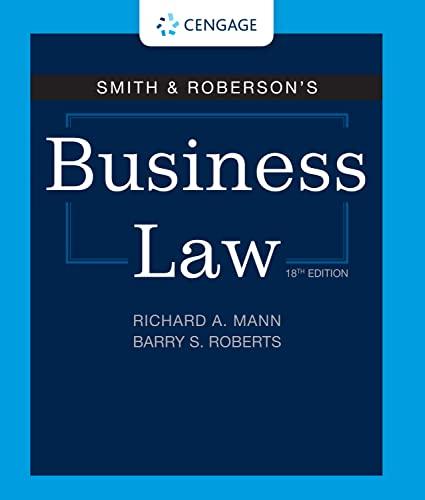Question
Chapter 9 Review Questions 1.What are the principal methods of enforcing judgments? 2.What changes is the government of Ontario considering with respect to who handles
Chapter 9
Review Questions
1.What are the principal methods of enforcing judgments?
2.What changes is the government of Ontario considering with respect to who handles the enforcement process?
3. In what circumstances would each of the following be used?
- a Mareva injunction
- a writ of seizure and sale
- a writ of sequestration
- an injunction
- garnishment proceedings
4. Is the judgment debtor the only person that can be examined in a JD exam?
5.Suppose a contempt motion is brought against a debtor who is obstructing a judgment debtor examination. On the motion, if the court orders thejudgment debtor to re-attend at their own expense, and the debtor does but continues to beobstructive, how can the serving of a second contempt motion be avoided? Why is this important?
6.Should a direction to enforce a writ of seizure and sale be filed with the sheriff every time a writ of seizure and sale is ?
7. How long after a writ of seizure and sale has been issued can it be filed?
- car
- car, where they are a salesperson and uses the car to meet customers
- Canada Pension Plan benefits
- clothing
- set of wrenches, where they are a mechanic and the judgment
.
8. Suppose that at a JD exam it is discovered that the judgment debtor has a joint bank account, a car, a house, income from employment, and income from a mortgage that a trustee owns and holds on the judgment debtor's behalf. What enforcement remedies would be used?
debtor's salary is the only asset? Would it make a difference if the debtor is employed by the federal government?
9. How long is the garnishee liable to make payments to the sheriff?
10. What can the creditor do if the garnishee serves a garnishee statement in which the garnishee says that there are no debts owing to the debtor and the creditor thinks this is untrue?
Review Questions
- In what way does the operation of the Small Claims Court assist litigants who are not represented?
- What are the Small Claims Court's jurisdictional limits?
- Explain the difference between equitable relief and equitable remedies. What is the role of each of these in Small Claims Court?
- If you operate a business in Kenora and have as part of your standard contract a section that says "the parties consent to all disputes being tried in the Small Claims Court at Kenora," does this allow you to sue for breach of contract in the Kenora Small Claims Court no matter where the defendant resides or carries on business?
- How do you prove to the court that your claim has been brought in the correct territorial division?
6. What choices do you have if you wish to sue a sole proprietorship? A partnership? A corporation?
7. In what circumstances would a party require a litigation guardian?
Step by Step Solution
There are 3 Steps involved in it
Step: 1

Get Instant Access to Expert-Tailored Solutions
See step-by-step solutions with expert insights and AI powered tools for academic success
Step: 2

Step: 3

Ace Your Homework with AI
Get the answers you need in no time with our AI-driven, step-by-step assistance
Get Started


